Questions for MET REGULAR SEP 2023
- Home
- Question Bank
- MET REGULAR SEP 2023
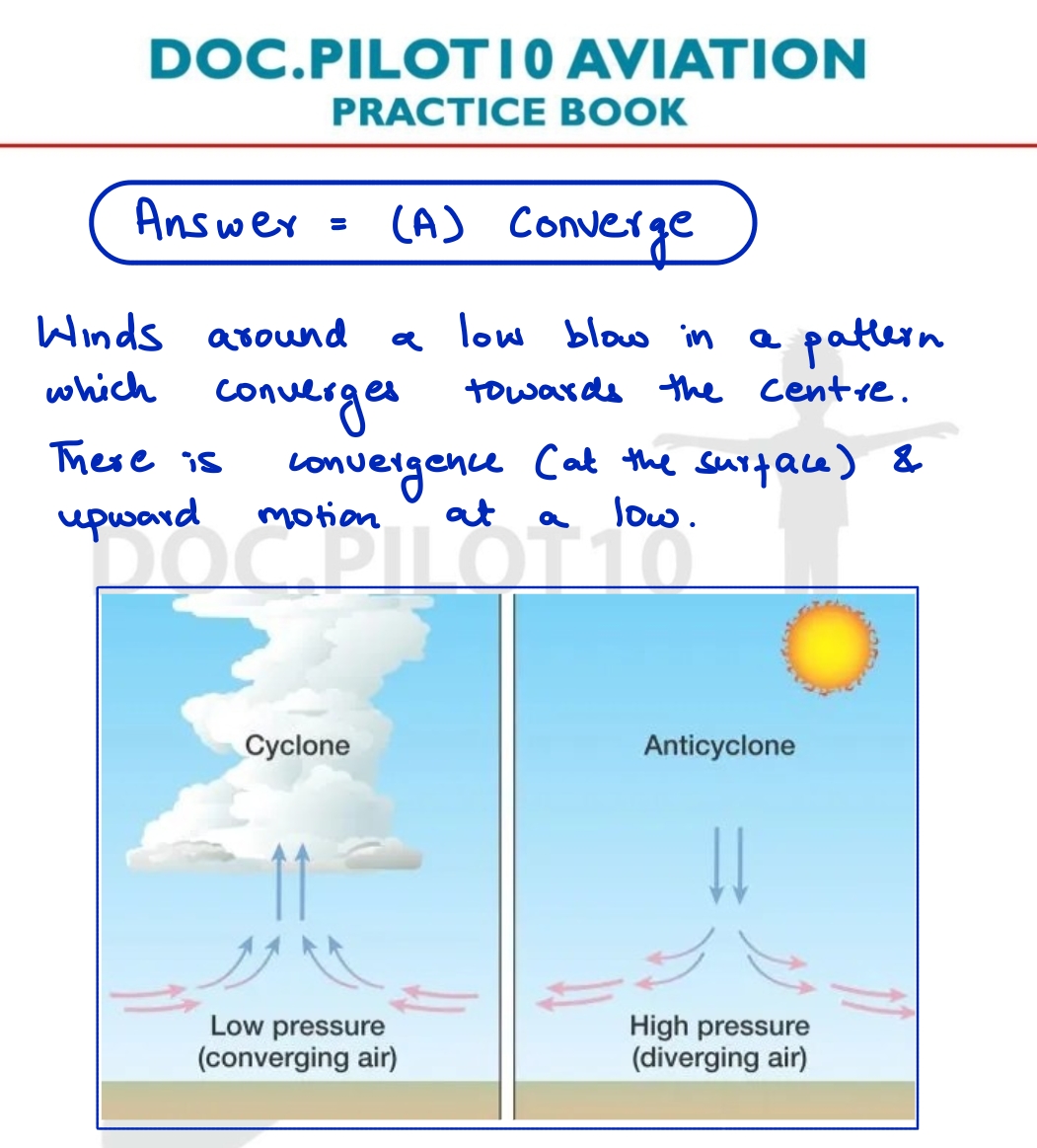 Near a low-pressure center, air flows from surrounding areas inward (convergence) and then rises, which promotes cloud and precipitation development.
Near a low-pressure center, air flows from surrounding areas inward (convergence) and then rises, which promotes cloud and precipitation development.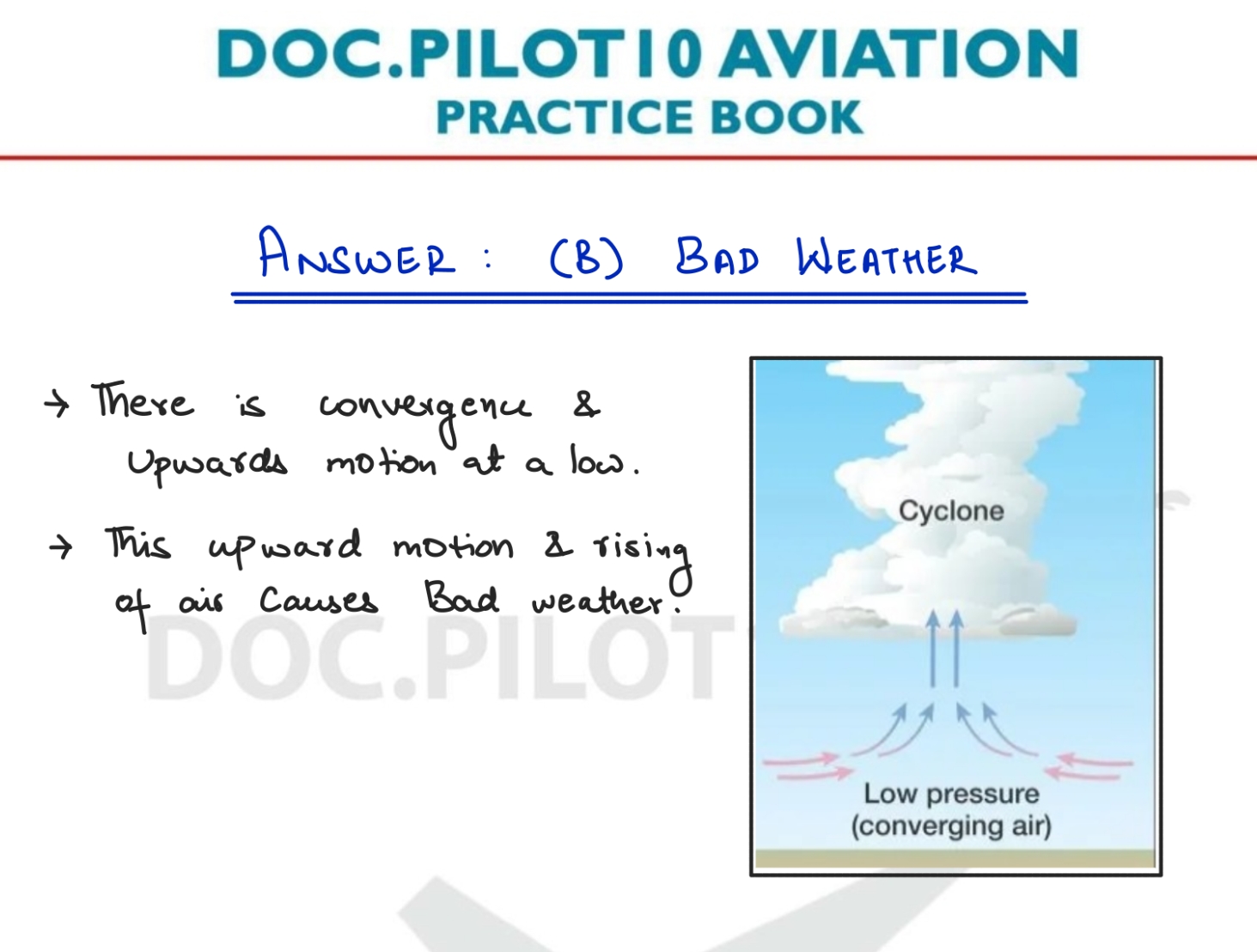 Low pressure causes air to converge and rise, encouraging cloud formation and precipitation—conditions commonly described as bad or unsettled weather.
Low pressure causes air to converge and rise, encouraging cloud formation and precipitation—conditions commonly described as bad or unsettled weather. High pressure areas are associated with subsidence and more stable conditions, often producing lighter, weaker surface winds compared with low-pressure systems.
High pressure areas are associated with subsidence and more stable conditions, often producing lighter, weaker surface winds compared with low-pressure systems.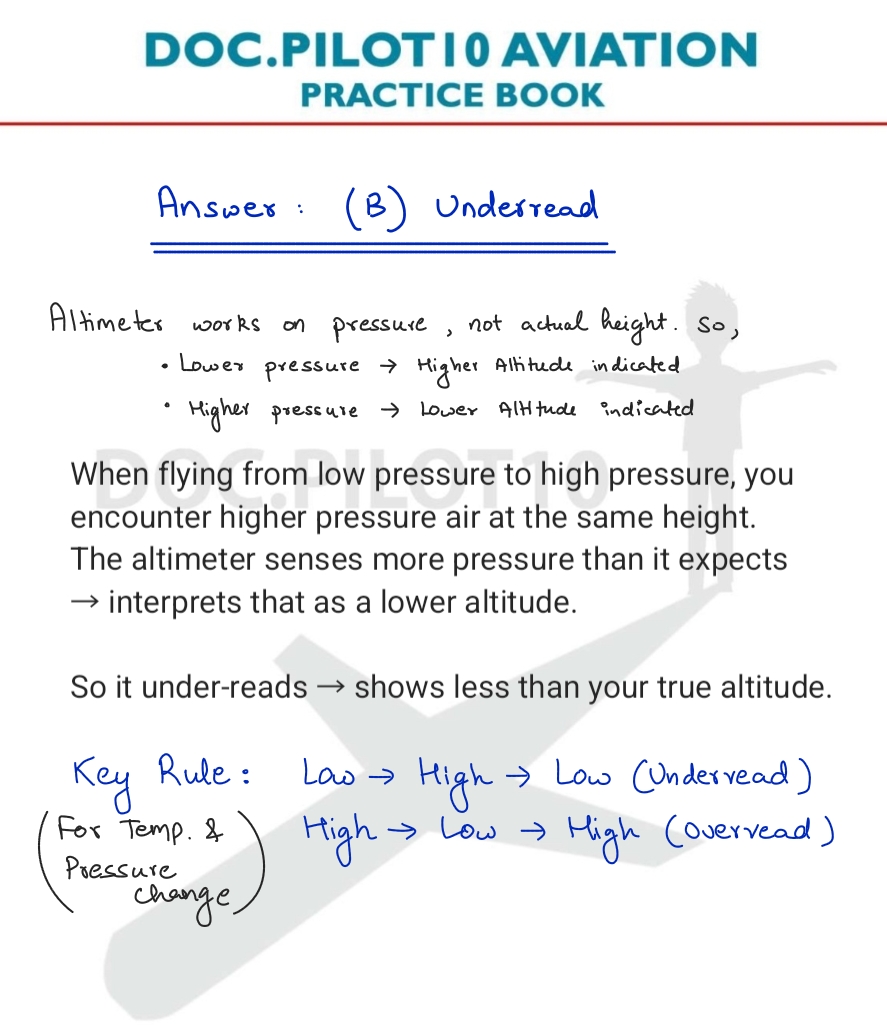 Moving from low to high pressure without resetting the altimeter causes the instrument to indicate a lower altitude than the aircraft’s true altitude (altimeter reads “under”).
Moving from low to high pressure without resetting the altimeter causes the instrument to indicate a lower altitude than the aircraft’s true altitude (altimeter reads “under”).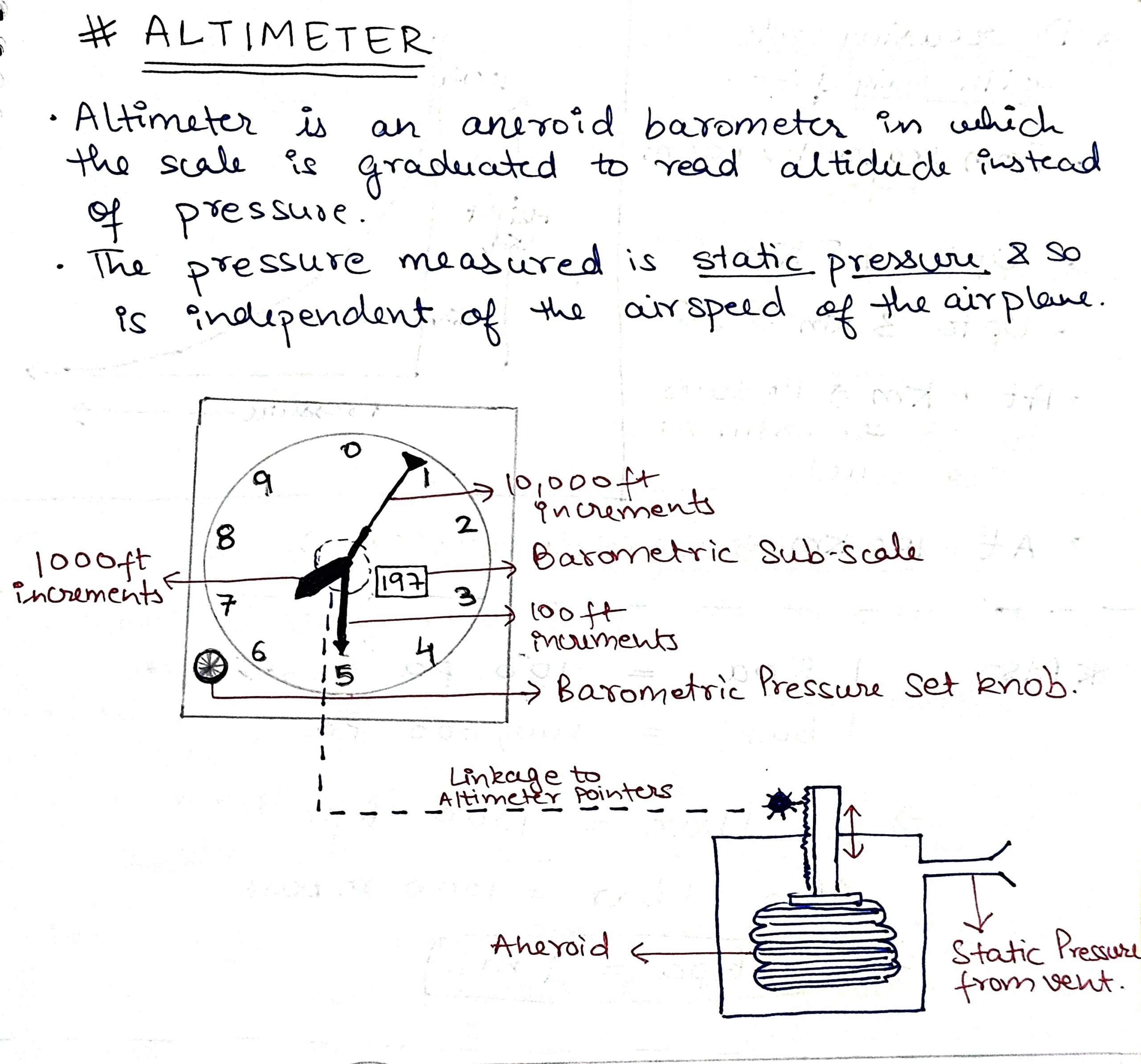 An altimeter is essentially an aneroid barometer: it senses ambient pressure with aneroid capsules and converts that pressure into altitude indications.
An altimeter is essentially an aneroid barometer: it senses ambient pressure with aneroid capsules and converts that pressure into altitude indications. A col is a saddle-like region between two highs and two lows, often characterized by weak pressure gradients and variable weather.
A col is a saddle-like region between two highs and two lows, often characterized by weak pressure gradients and variable weather.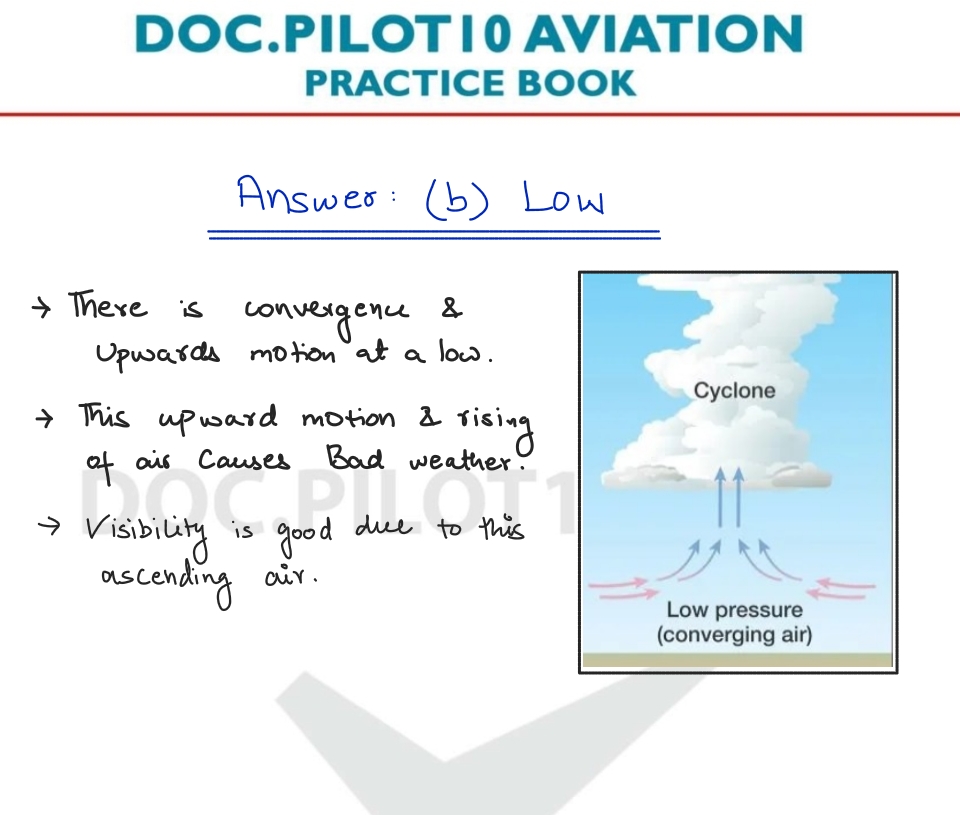 Bad weather is typically associated with low-pressure systems. (Good visibility usually comes with highs, but the exam intent is that low = bad weather.)
Bad weather is typically associated with low-pressure systems. (Good visibility usually comes with highs, but the exam intent is that low = bad weather.) Altimeters use the known relationship between atmospheric pressure and height (pressure decreases with altitude) to display an aircraft’s altitude above a reference datum.
Altimeters use the known relationship between atmospheric pressure and height (pressure decreases with altitude) to display an aircraft’s altitude above a reference datum.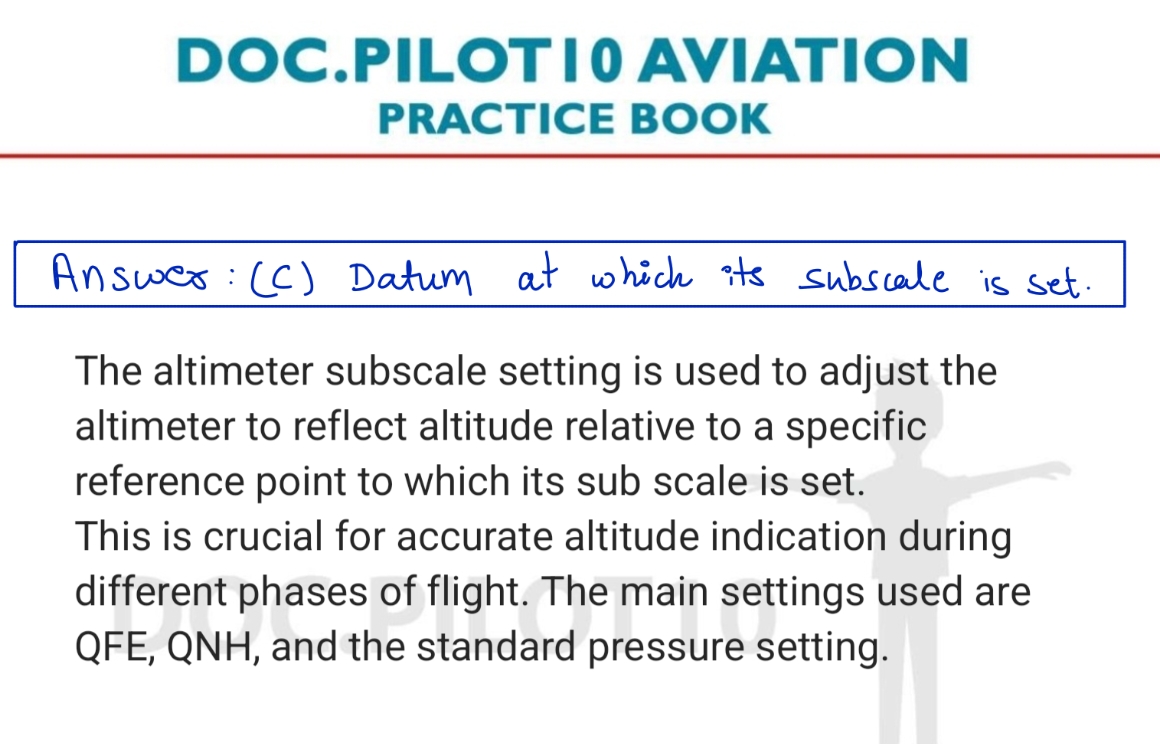 An altimeter indicates height relative to the pressure datum set on its sub-scale (QNH/QFE/1013.2, etc.). The displayed altitude depends on that setting.
An altimeter indicates height relative to the pressure datum set on its sub-scale (QNH/QFE/1013.2, etc.). The displayed altitude depends on that setting.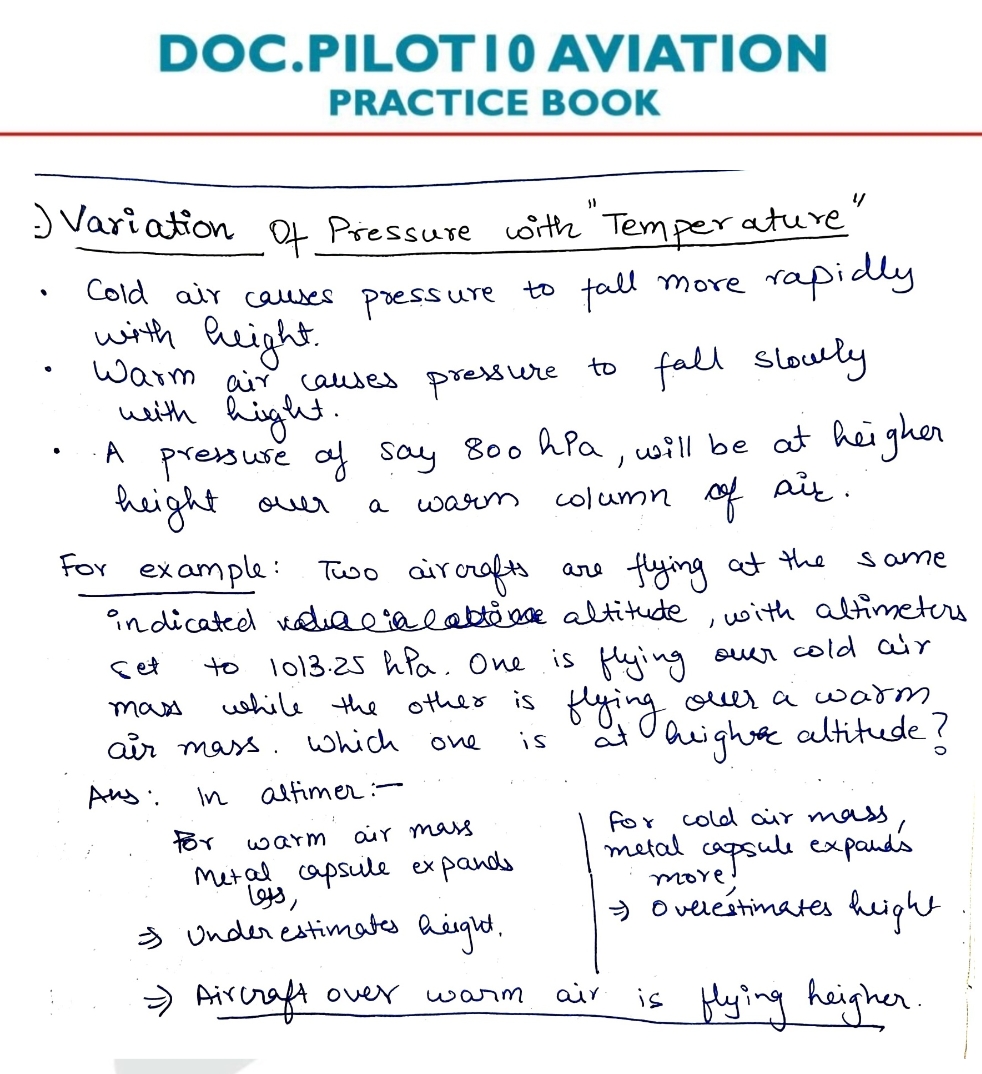 Warm air expands, raising pressure surfaces and meaning an aircraft at the same pressure level sits higher (true altitude greater) in warm air than in cold air.
Warm air expands, raising pressure surfaces and meaning an aircraft at the same pressure level sits higher (true altitude greater) in warm air than in cold air.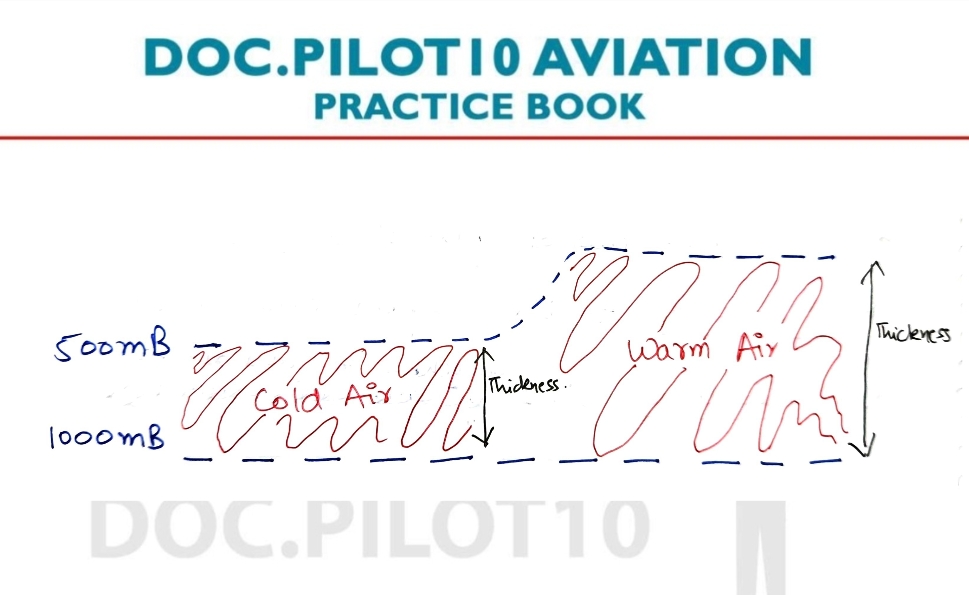 Warm air is less dense and has a larger scale height, so pressure decreases more slowly with altitude compared to cold air—thus the fall is less rapid.
Warm air is less dense and has a larger scale height, so pressure decreases more slowly with altitude compared to cold air—thus the fall is less rapid.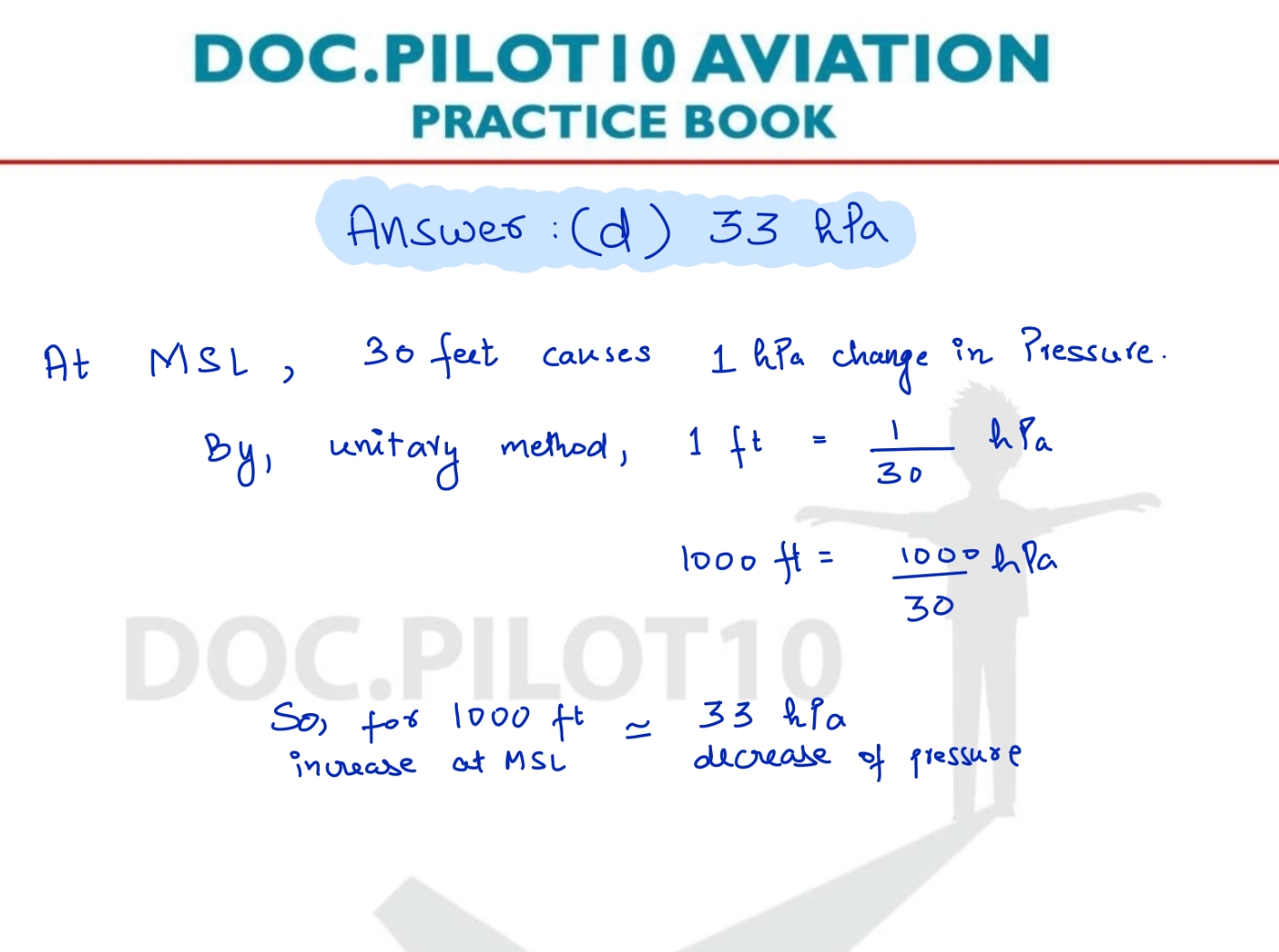 Near sea level a rough rule-of-thumb is around 30–35 hPa per 1000 ft, so the closest choice is 33 hPa for a 1000 ft increase.
Near sea level a rough rule-of-thumb is around 30–35 hPa per 1000 ft, so the closest choice is 33 hPa for a 1000 ft increase.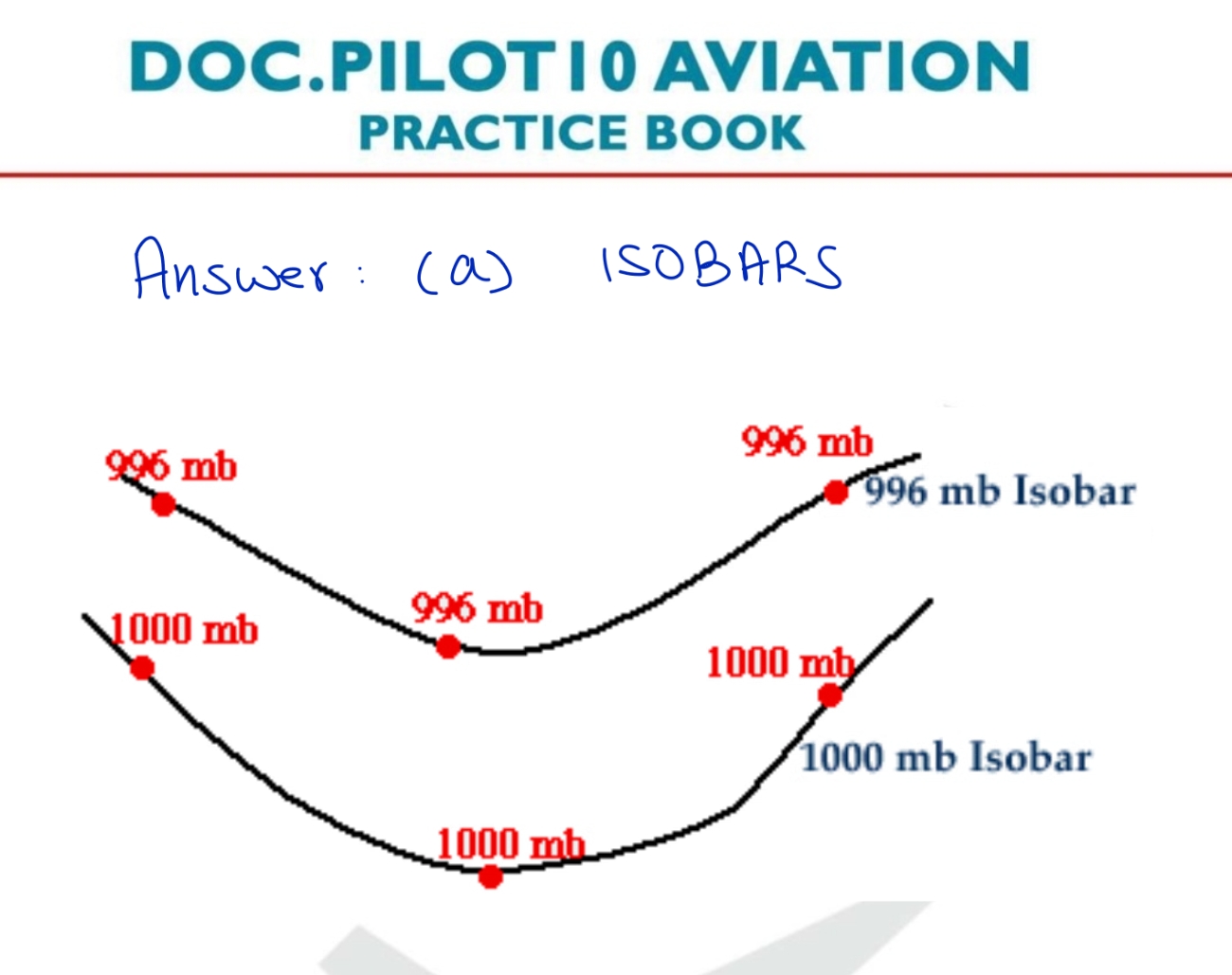 Isobars connect points of equal atmospheric pressure on weather maps and are used to identify pressure systems and gradients.
Isobars connect points of equal atmospheric pressure on weather maps and are used to identify pressure systems and gradients.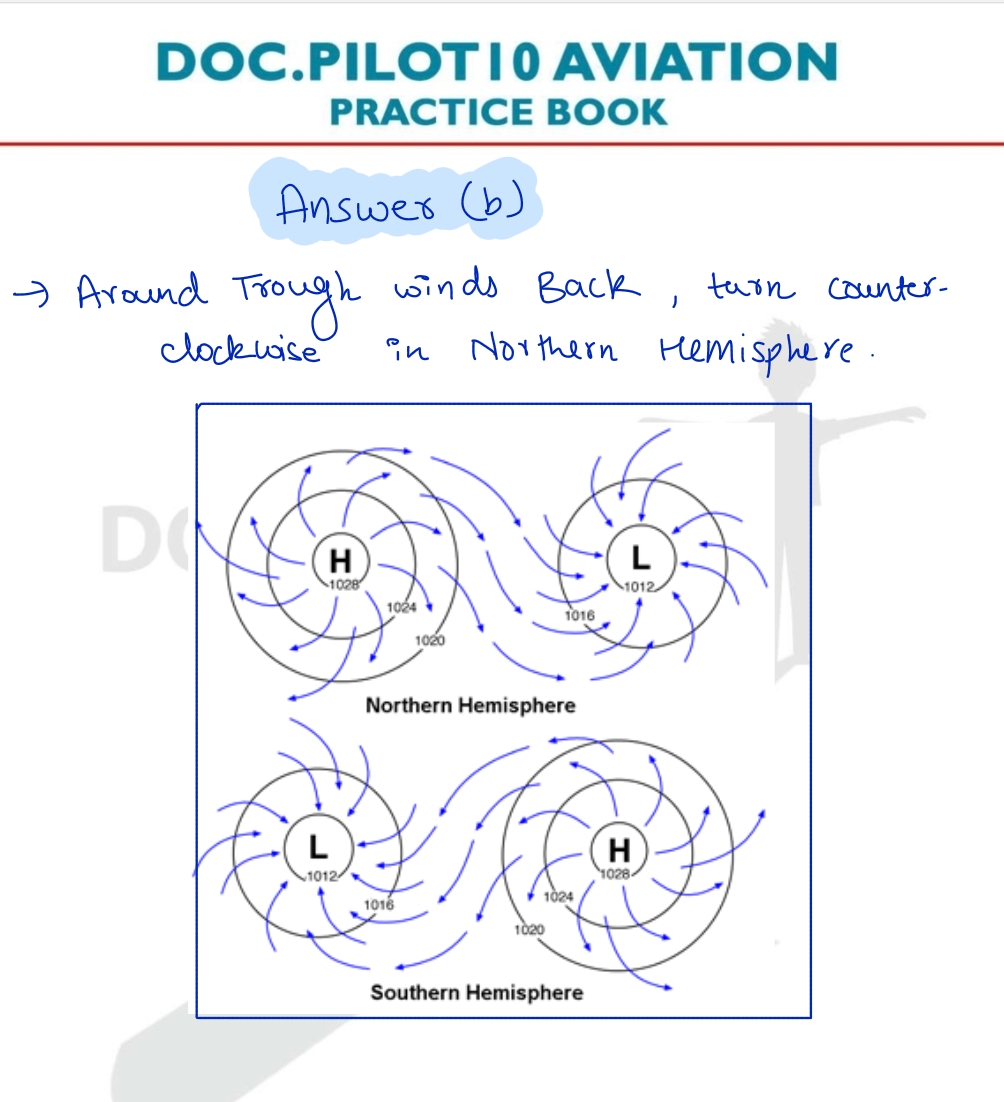 Troughs often show frontal characteristics such as ascending motion and cloud formation along their axis—this is the key identifying feature compared to a simple wave.
Troughs often show frontal characteristics such as ascending motion and cloud formation along their axis—this is the key identifying feature compared to a simple wave.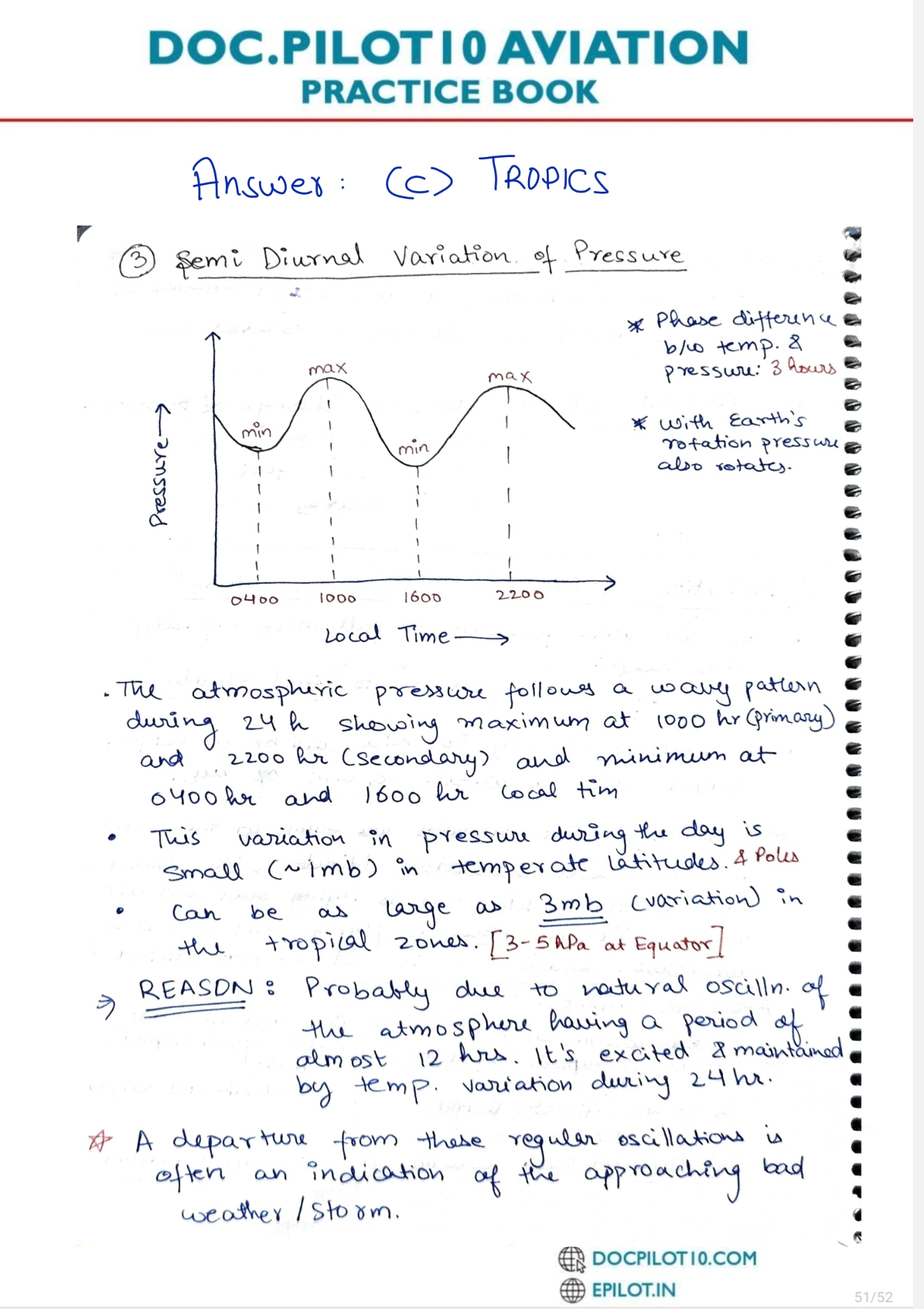 Semi-diurnal (twice daily) pressure oscillations are most noticeable in the tropics, driven by atmospheric tides related to solar heating.
Semi-diurnal (twice daily) pressure oscillations are most noticeable in the tropics, driven by atmospheric tides related to solar heating.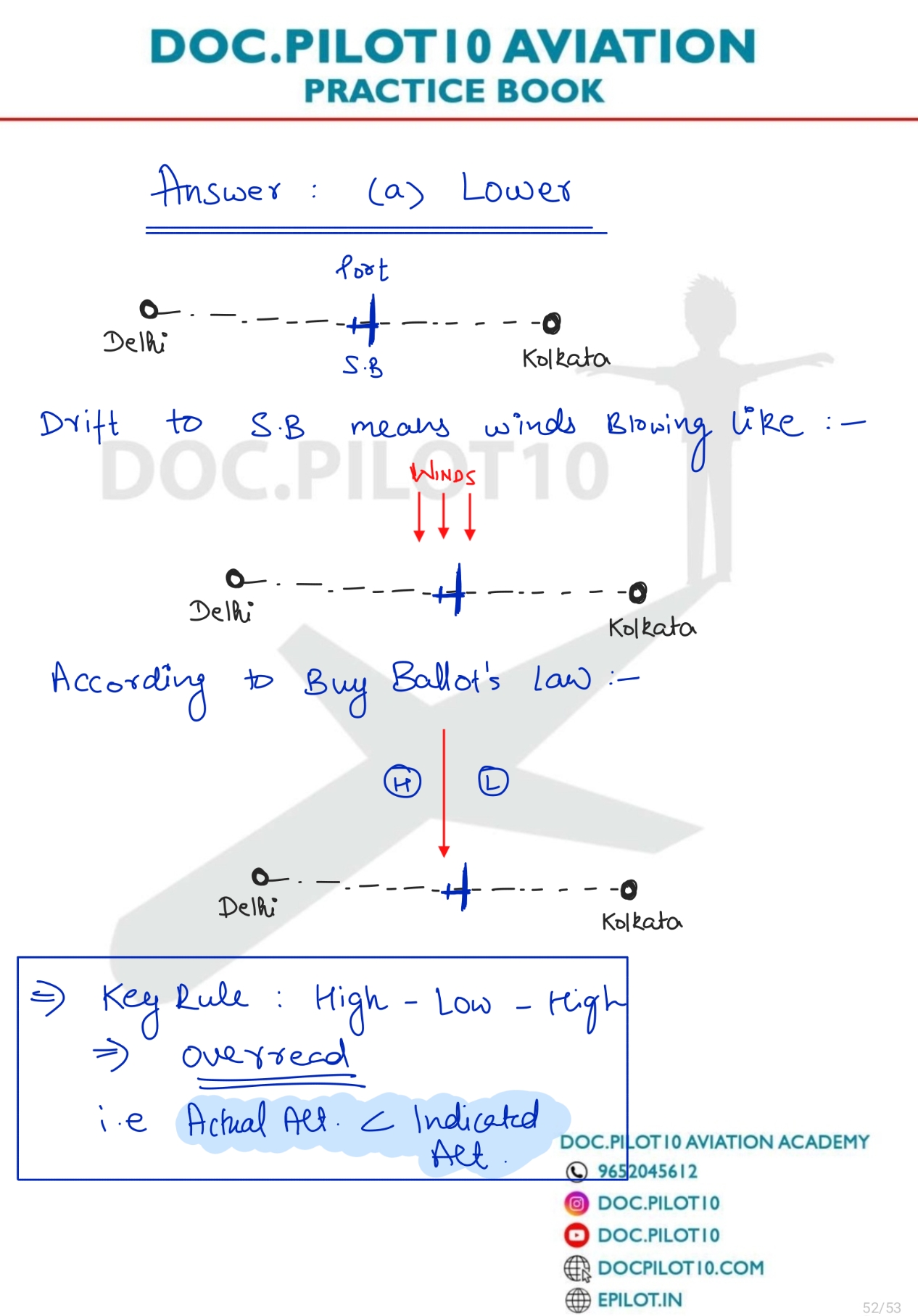 Crosswind drift affects ground track but not directly the vertical dimension; if indicated altitude is held constant and pressure and settings are unchanged, true altitude remains essentially the same.
Crosswind drift affects ground track but not directly the vertical dimension; if indicated altitude is held constant and pressure and settings are unchanged, true altitude remains essentially the same.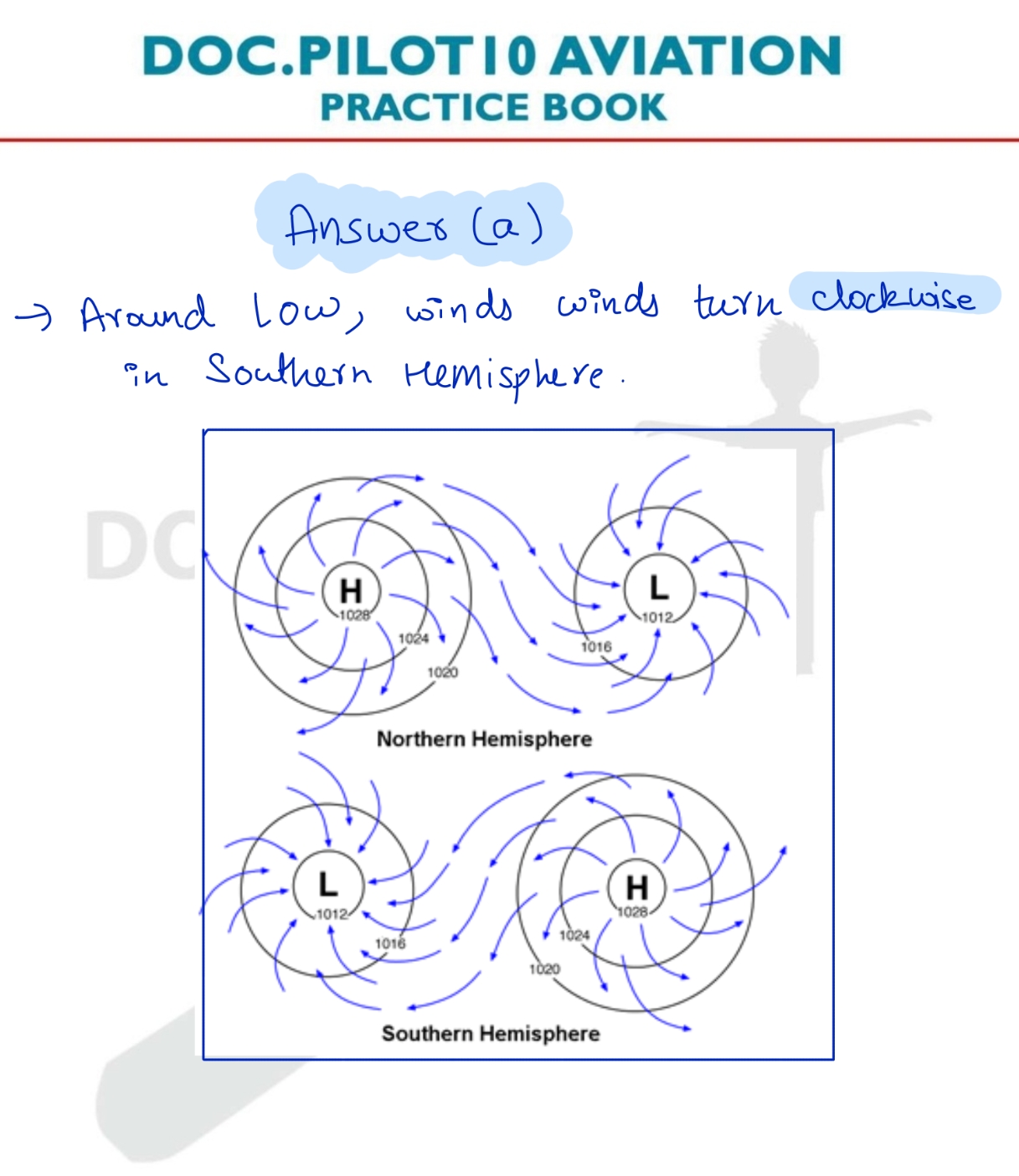 In the Southern Hemisphere, cyclonic (low) circulation is clockwise due to the Coriolis effect; anticlockwise is for the Northern Hemisphere.
In the Southern Hemisphere, cyclonic (low) circulation is clockwise due to the Coriolis effect; anticlockwise is for the Northern Hemisphere.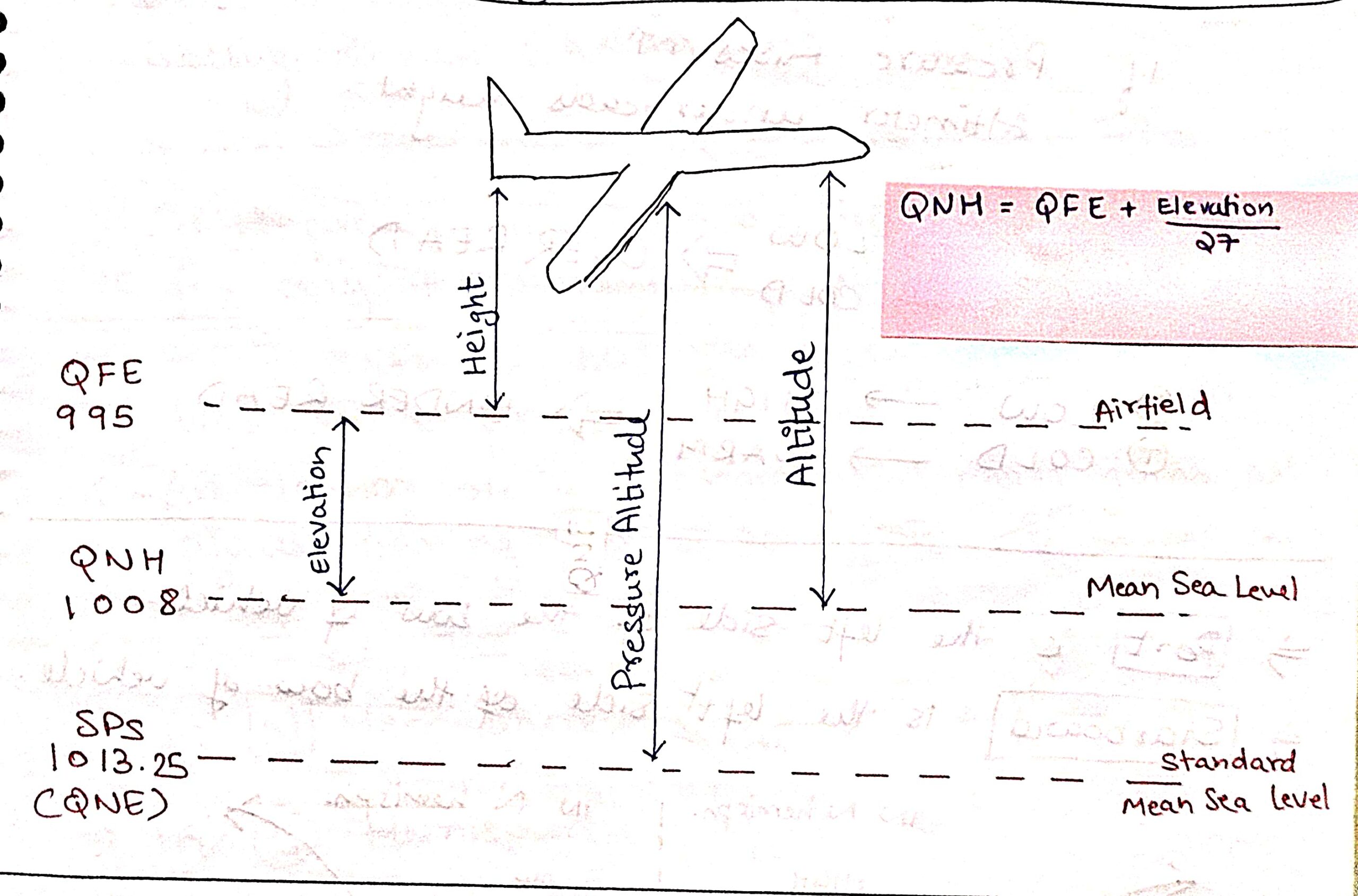 Setting QNH (sea-level pressure reduced) on the altimeter allows it to read the aerodrome elevation when the aircraft is on the ground.
Setting QNH (sea-level pressure reduced) on the altimeter allows it to read the aerodrome elevation when the aircraft is on the ground.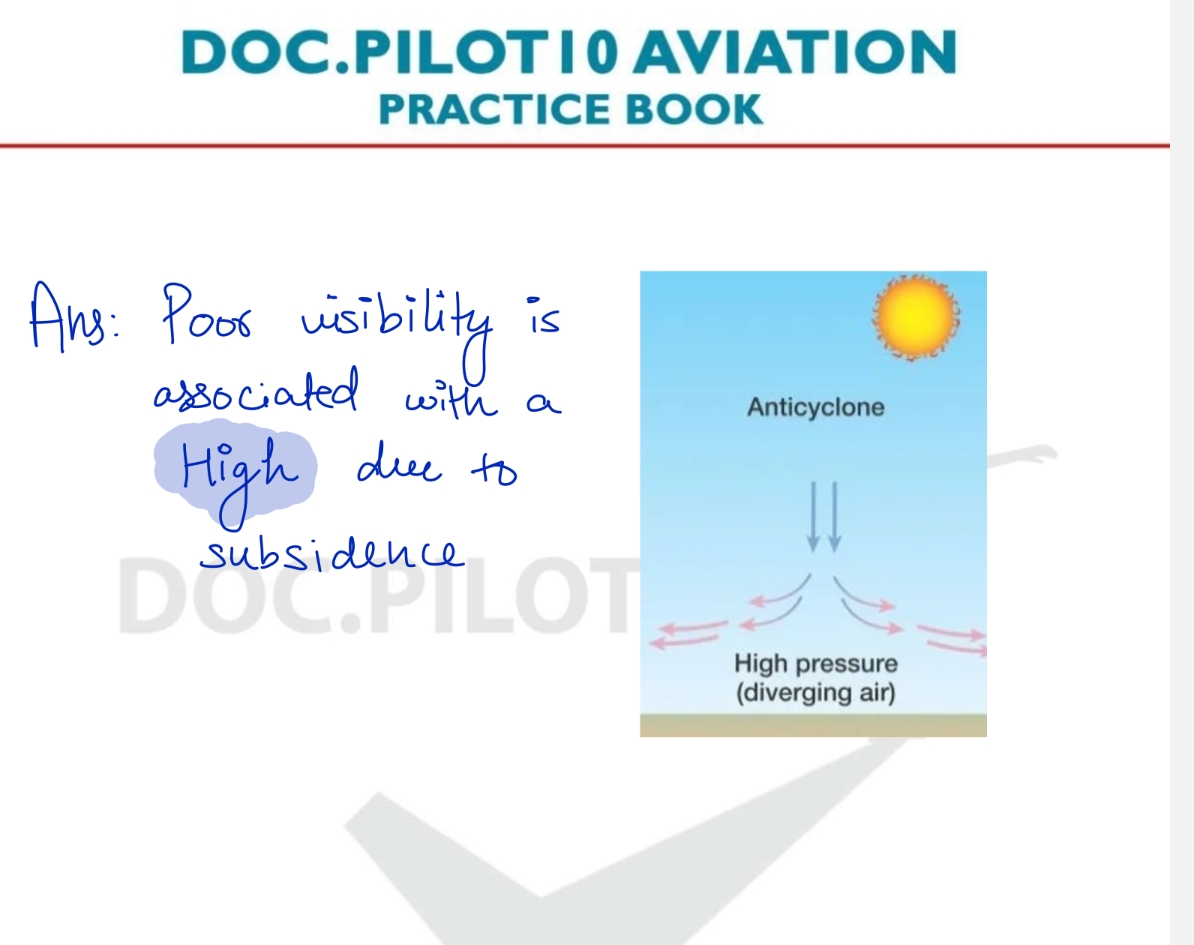 High-pressure conditions encourage subsidence and temperature inversions that can trap pollutants and moisture, often reducing visibility (haze, mist).
High-pressure conditions encourage subsidence and temperature inversions that can trap pollutants and moisture, often reducing visibility (haze, mist). Perpendicular to a trough axis, pressure increases away from the trough (i.e., pressures rise on either side of the trough axis).
Perpendicular to a trough axis, pressure increases away from the trough (i.e., pressures rise on either side of the trough axis). In cold air the atmosphere is denser and the scale height is smaller, so pressure falls more rapidly with height than in warm air.
In cold air the atmosphere is denser and the scale height is smaller, so pressure falls more rapidly with height than in warm air. In the standard atmosphere, the 300 hPa pressure level lies roughly around 30,000 ft (≈9–10 km) and is commonly used in high-altitude charts.
In the standard atmosphere, the 300 hPa pressure level lies roughly around 30,000 ft (≈9–10 km) and is commonly used in high-altitude charts. 500 hPa is approximately at 18,000 ft (≈5.5 km) in the standard atmosphere and is a key mid-tropospheric pressure level for weather analysis.
500 hPa is approximately at 18,000 ft (≈5.5 km) in the standard atmosphere and is a key mid-tropospheric pressure level for weather analysis. The 200 hPa level is high in the atmosphere, roughly around 40,000 ft (~12 km), often used to analyze upper-level jet streams.
The 200 hPa level is high in the atmosphere, roughly around 40,000 ft (~12 km), often used to analyze upper-level jet streams. About 24,000 ft (~7.3 km) corresponds roughly to the 400 hPa level in ISA; 300 hPa is higher (~30,000 ft) and 500 hPa lower (~18,000 ft).
About 24,000 ft (~7.3 km) corresponds roughly to the 400 hPa level in ISA; 300 hPa is higher (~30,000 ft) and 500 hPa lower (~18,000 ft).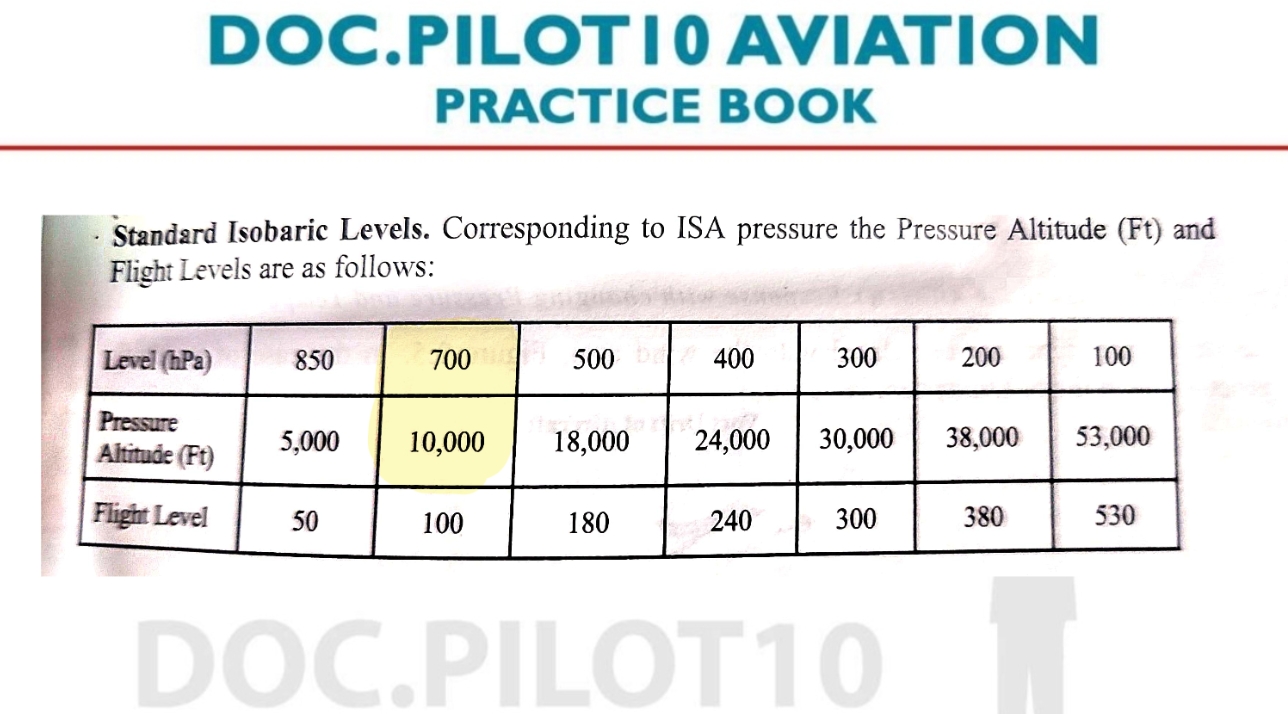 700 hPa is typically near 10,000 ft (≈3 km) in the standard atmosphere and is used for lower-troposphere analyses.
700 hPa is typically near 10,000 ft (≈3 km) in the standard atmosphere and is used for lower-troposphere analyses. Around 40,000 ft you reach roughly the 200 hPa pressure level, characteristic of upper-tropospheric/ lower-stratospheric altitudes.
Around 40,000 ft you reach roughly the 200 hPa pressure level, characteristic of upper-tropospheric/ lower-stratospheric altitudes. The 850 hPa surface typically lies near 1.5 km or ~5,000 ft above sea level in ISA, commonly used in low-level weather analyses.
The 850 hPa surface typically lies near 1.5 km or ~5,000 ft above sea level in ISA, commonly used in low-level weather analyses. Atmospheric pressure results from the weight of the air column above a point — that weight is caused by gravity acting on the air mass.
Atmospheric pressure results from the weight of the air column above a point — that weight is caused by gravity acting on the air mass.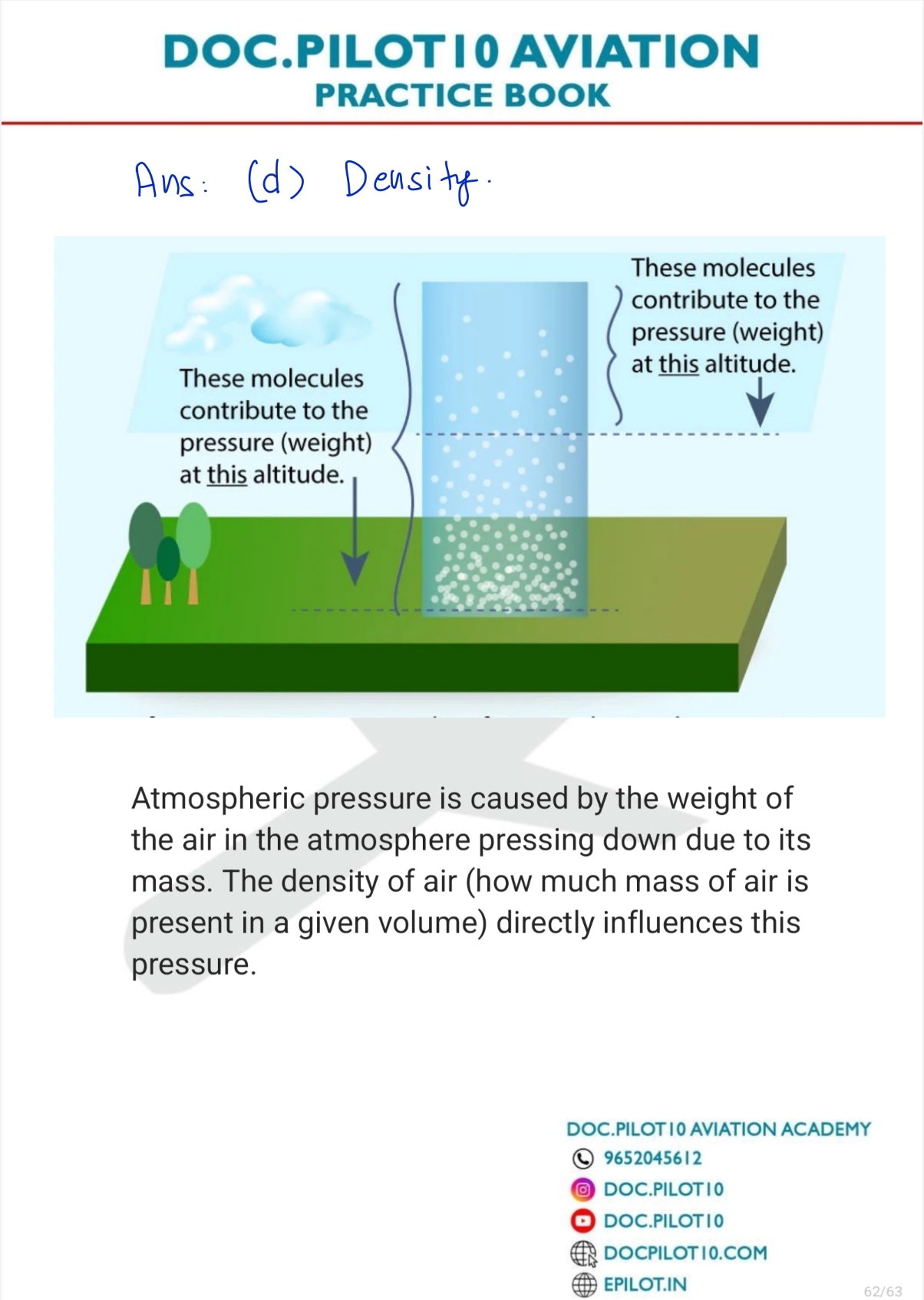 If the surrounding standard pressure (or QNH) rises, pressure surfaces move upward; this can make true altitude change while the altimeter reading (based on earlier setting) appears unchanged.
If the surrounding standard pressure (or QNH) rises, pressure surfaces move upward; this can make true altitude change while the altimeter reading (based on earlier setting) appears unchanged.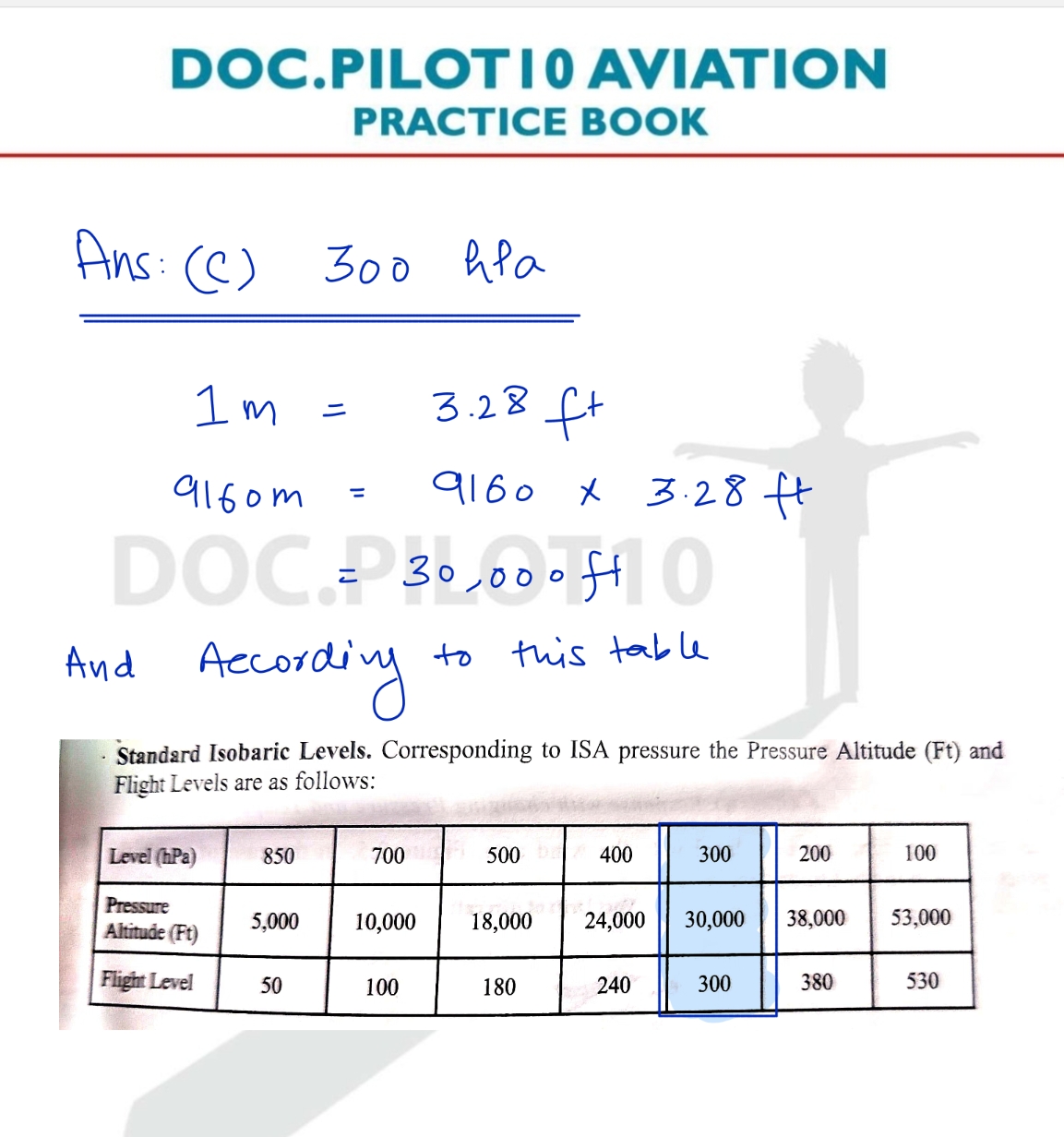 A geopotential height around 9,160 m is characteristic of the 300 hPa level in the standard atmosphere, so that contour fits a 300 hPa chart.
A geopotential height around 9,160 m is characteristic of the 300 hPa level in the standard atmosphere, so that contour fits a 300 hPa chart. On 300 hPa charts the geopotential height contours (isohypses) are typically plotted at 60 gpm intervals to show larger-scale upper-level patterns.
On 300 hPa charts the geopotential height contours (isohypses) are typically plotted at 60 gpm intervals to show larger-scale upper-level patterns. 500 hPa charts commonly use 40 gpm contour intervals to represent mid-level flow and trough/ridge structure in meteorology.
500 hPa charts commonly use 40 gpm contour intervals to represent mid-level flow and trough/ridge structure in meteorology.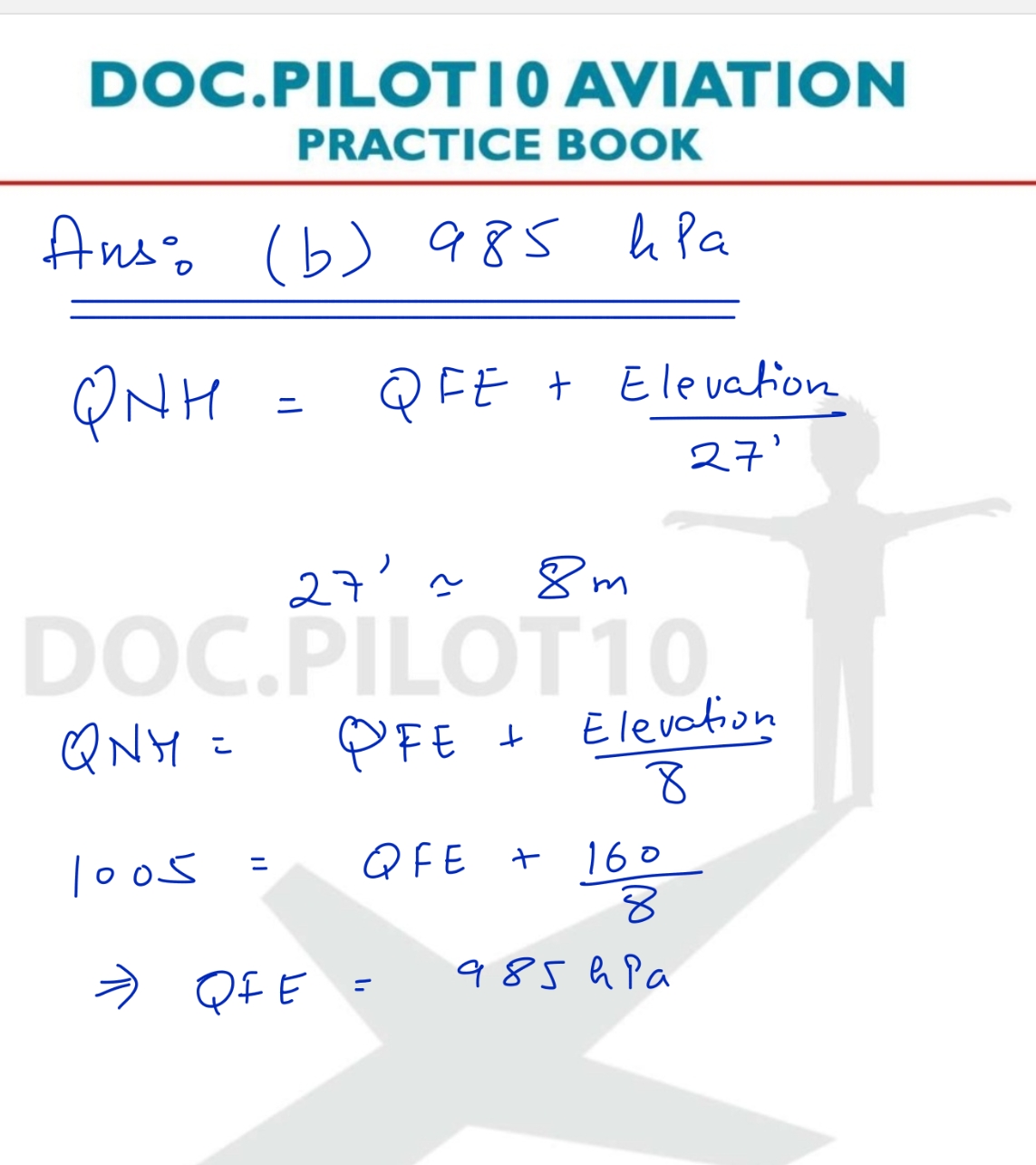 QFE = QNH − (elevation / 8). For 160 m, pressure difference ≈ 160/8 = 20 hPa. So QFE = 1005 − 20 = 985 hPa.
QFE = QNH − (elevation / 8). For 160 m, pressure difference ≈ 160/8 = 20 hPa. So QFE = 1005 − 20 = 985 hPa. A steep pressure gradient corresponds to isobars packed closely together, indicating stronger winds as the pressure force is greater over a short distance.
A steep pressure gradient corresponds to isobars packed closely together, indicating stronger winds as the pressure force is greater over a short distance.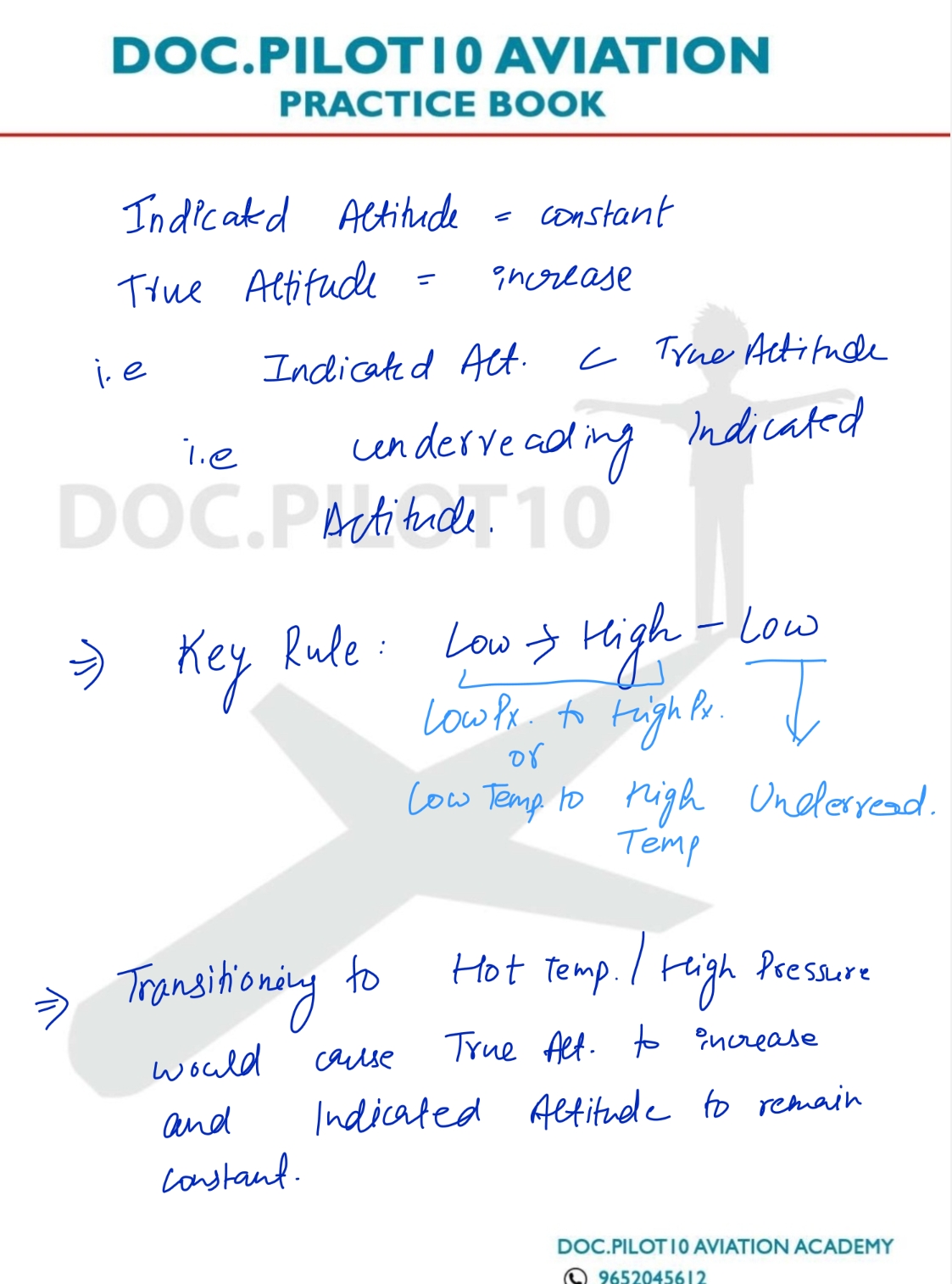 Warming of the air column expands the atmosphere and raises pressure surfaces, so in hot conditions (especially with high pressure the surface reference) the true altitude at a given pressure level can increase.
Warming of the air column expands the atmosphere and raises pressure surfaces, so in hot conditions (especially with high pressure the surface reference) the true altitude at a given pressure level can increase.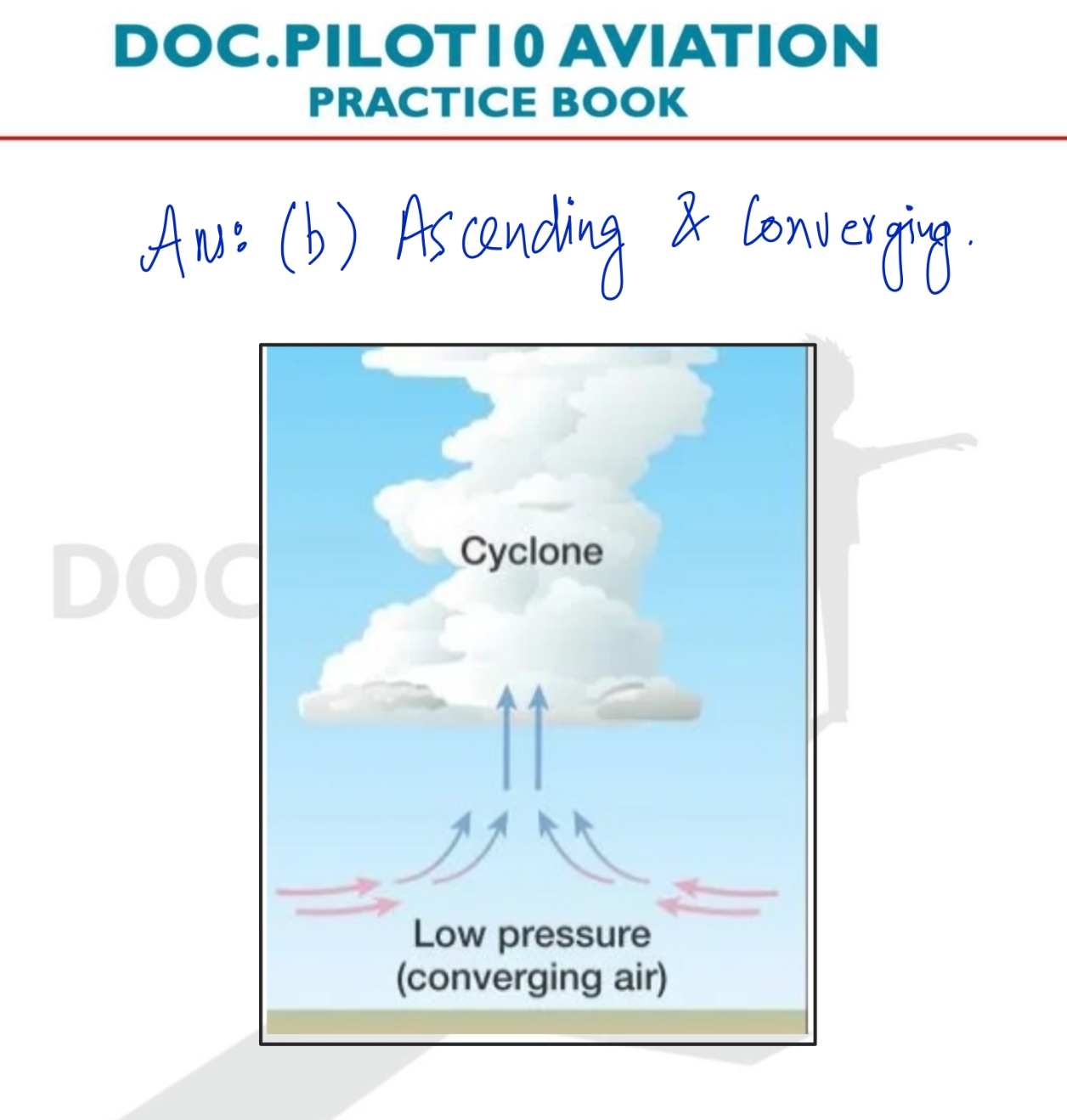 Cyclones (lows) feature converging surface winds which are forced to rise; this ascent fuels cloud and precipitation processes associated with the cyclone.
Cyclones (lows) feature converging surface winds which are forced to rise; this ascent fuels cloud and precipitation processes associated with the cyclone.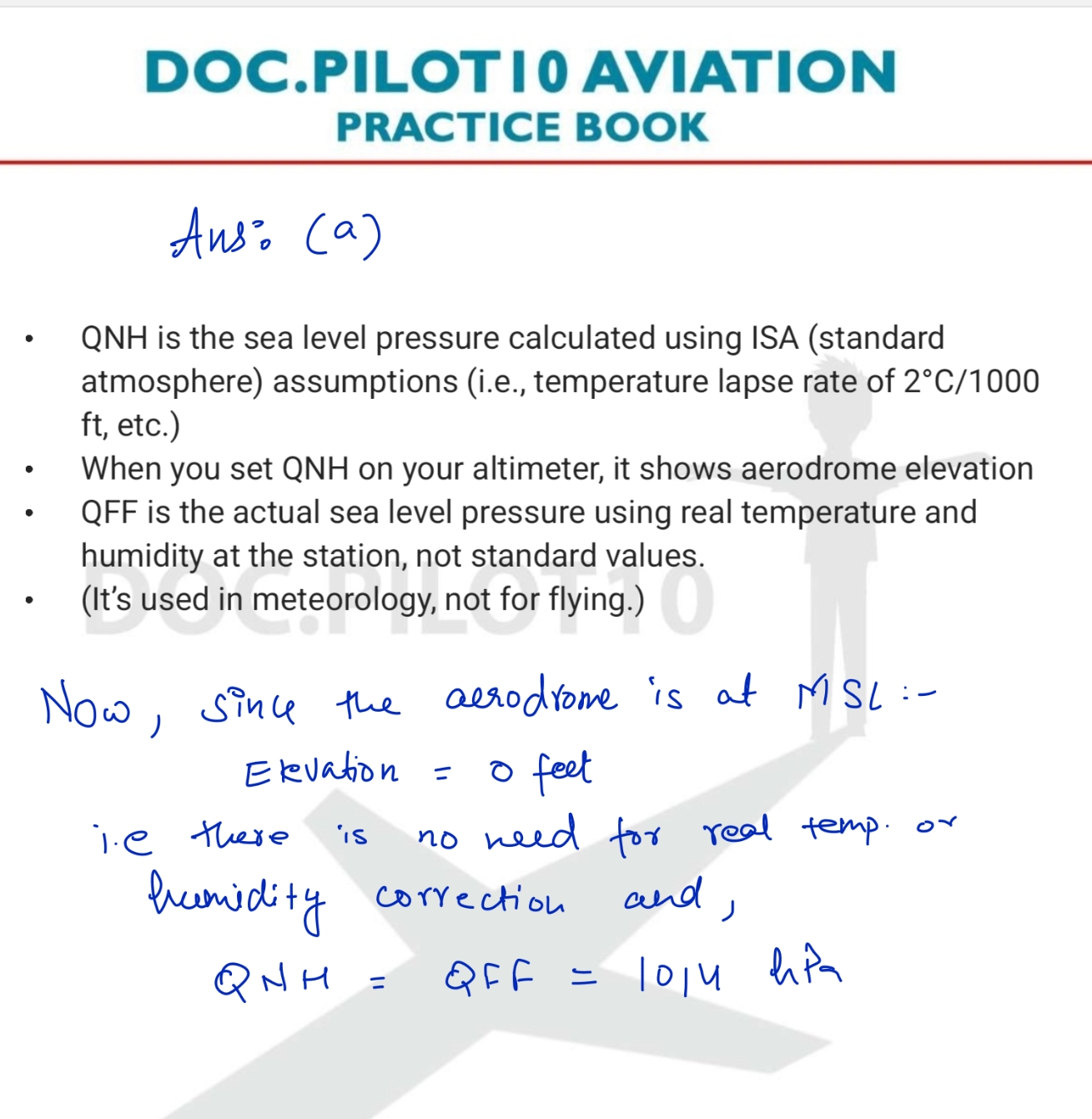 If the aerodrome is at mean sea level, QNH (sea-level reduced pressure) and QFF (actual sea-level pressure reduced for temperature) are effectively the same, so QFF = 1014.0 hPa.
If the aerodrome is at mean sea level, QNH (sea-level reduced pressure) and QFF (actual sea-level pressure reduced for temperature) are effectively the same, so QFF = 1014.0 hPa.

At Kerala Flight Academy, we are committed to providing exceptional aviation training. Join us to launch your career in the skies with expert instructors, state-of-the-art facilities, and comprehensive support. Your journey to becoming an aviation professional starts here!
Keralaflightacademy, Near Calicut International Airport 673647